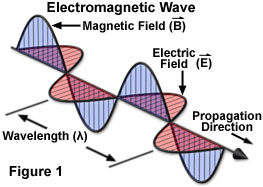Physics for Everyone: The Nature of Light
Just what is light? If you ask anyone on the street, you might get varying answers, but very few of them will tell the whole picture. Some people might say a photon, but just what do they mean by a photon? What is a photon? Is just one photon light, or are a bunch of photons light? Either way, how does this ambiguous thing generate the images we see? Or does it even generate those images?
If the answer were “a photon,” that answer would technically be correct. Light is, at its most basic element, a photon, or a collection of photons. That photon is the smallest component of light – it doesn’t get smaller than that. BUT, the photon is made up of something. While it can be considered a particle (and is!), the photon is also a wave. And, in actuality, it can be thought of as TWO waves.
How is that? A photon is an electromagnetic wave. But what exactly does that mean? Essentially, an electromagnetic wave is a wave generated by an interacting electric field and magnetic field. One of the interesting properties of electric and magnetic fields, is that a changing electric field generates a magnetic field, and vice versa. What happens “inside” a photon, is you have, perpendicular to each other, both a constantly changing magnetic and electric field (which can each be viewed as its own wave, each wave perpendicular to the other) – so as the magnetic field changes, it generates the electric field, and vice versa – essentially a self-perpetuating system. The photon itself travels in a direction transverse, or perpendicular, to the motion of both fields (and that’s what allows light to be able to travel without a medium in which to travel, a property no other wave has).

But didn’t I say it’s a particle? How can it be both a particle and a wave. Yes, I did say exactly that. One of the interesting things about this universe we live in is that we have wave-particle duality.
All particles are also waves (but not all waves are particles!). Easiest way to think of it is to recognize the fact that everything in the universe is energy. Even matter is just another form of energy. And we have no problems thinking of energy as waves – we see it all the time in science fiction, or even in auto-shops, where one form of energy or another is expressed as a wave-form on some read-out device. Matter, light, and all particles, are no different. The difference between matter waves, light waves, and other more familiar waves (such as sound waves, ocean waves, or earthquake waves), is that matter waves and photons are localized.
What’s that mean? Localization of a wave essentially means that there is something in its mathematical expression that isolates its position – that “tells” it where it is, and that is in one place (which can be, and always is, moving). Just to put it out there, mathematically we call it a Dirac delta function, but for the purposes of this little article, that’s not important.
How can we “see” these photons?
Being an electro-magnetic wave, a photon can be absorbed by any atom, should the photon possess the right frequency (not all atoms can absorb all photons due to certain quantum mechanical effects which I’ll explain in a later article). The way we see photons, is that, when they strike our cornea, they are absorbed by the atoms in the cornea, which energizes it, and allows that now excited and agitated atom to bump around, passing on its agitation so that an electrical signal is sent down the optical nerve informing our brain about that photons frequency, which our brain interprets as a color and brightness.
So, to sum up, light is a particle that results from the interaction of electric and magnetic fields that conspire to generate a localized, self-propagating transverse wave.
|



